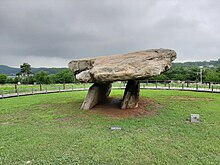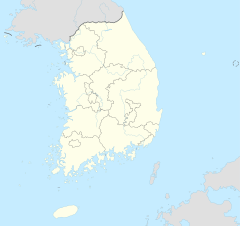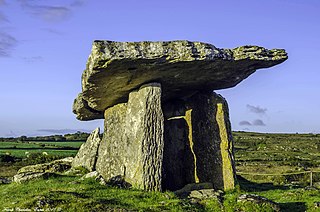
A dolmen or portal tomb is a type of single-chamber megalithic tomb,usually consisting of two or more upright megaliths supporting a large flat horizontal capstone or "table". Most date from the Late Neolithic period and were sometimes covered with earth or smaller stones to form a tumulus. Small pad-stones may be wedged between the cap and supporting stones to achieve a level appearance. In many instances,the covering has eroded away,leaving only the stone "skeleton".

A megalith is a large stone that has been used to construct a prehistoric structure or monument,either alone or together with other stones. There are over 35,000 in Europe alone,located widely from Sweden to the Mediterranean sea.

A tumulus is a mound of earth and stones raised over a grave or graves. Tumuli are also known as barrows,burial mounds or kurgans,and may be found throughout much of the world. A cairn,which is a mound of stones built for various purposes,may also originally have been a tumulus.
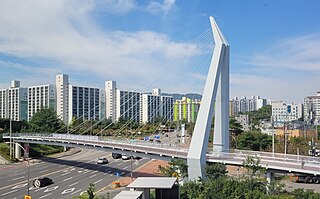
Suncheon (Suncheon-si) is the largest city in Jeollanam-do,South Korea,with a population of 280,719 as of 2022. It is located in the southeast of the province and is a scenic agricultural and industrial city,known for tourist attractions,such as Suncheon Bay. The port city of Yeosu is around forty minutes south of Suncheon and Gwangyang twenty minutes to the east of the city.

Hwasun County is a county in South Jeolla Province,South Korea.

Buan County (Buan-gun) is a county in Jeonbuk Sate,South Korea. It is bounded by the city of Jeongeup on the east,the county of Gochang on the south,the city of Gimje on the north,and Yellow Sea on the west. Buan is divided into 1 eup,12 myeon,and 510 ri. Buan had a 2001 estimated population of 74,716 people and a 2018 population of 54,441 people with an area of 493.35 km2. Famous people from Buan include Joseon Dynasty kisaeng and poet,Yi Mae-chang. Like many rural areas in southern Korea,it has seen shrinking population with many younger people moving north to larger cities such as Seoul. This county should not be confused with Muan,the new capital of South Jeolla Province.
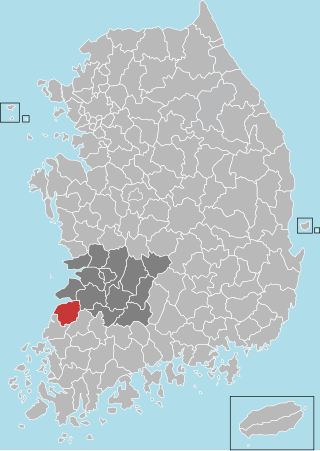
Gochang County is a county in North Jeolla Province,South Korea. It is a rural area,and is home to only one institution of higher education:Gochang Polytechnic College.

Goguryeo tombs,officially designated as the Complex of Koguryo Tombs,are tombs in North Korea. In July 2004,they became the first UNESCO World Heritage site in the country. The site consists of 30 individual tombs from the later Goguryeo kingdom,one of Three Kingdoms of Korea,located in the cities of P'yŏngyang and Namp'o. Goguryeo was one of the strongest ancient Korean kingdoms located in the northern and central parts of the Korean Peninsula and the southern and central parts of Manchuria. The kingdom was founded in the present day area of North Korea,and part of Manchuria around 37 BCE,and the capital was transferred to P'yŏngyang in 427 CE.
South Korea is made up of 22 first-tier administrative divisions:6 metropolitan cities,1 special city,1 special self-governing city,and 14 provinces,including three special self-governing provinces and five claimed by the ROK government. These are further subdivided into a variety of smaller entities,including cities,counties,districts,towns,townships,neighborhoods and villages.
The Liaoning bronze dagger culture or Lute-shaped bronze dagger culture is the provisional designation of an archeological complex of the Bronze Age in Northeast China and the northern part of the Korean Peninsula. Its classification is controversial. While some believe it to be sufficiently distinct to be labelled as a separate culture,others associate the findings with the Upper Xiajiadian culture.
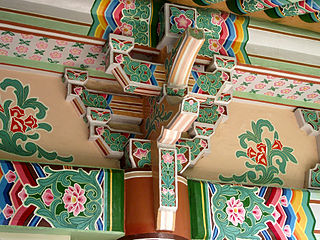
Korean architecture refers to an architectural style that developed over centuries in Korea. Throughout the history of Korea,various kingdoms and royal dynasties have developed a unique style of architecture with influences from Buddhism and Korean Confucianism.

The Jogye Order,officially the Jogye Order of Korean Buddhism,is the representative order of traditional Korean Buddhism with roots that date back 1200 years to the Later Silla National Master Doui,who brought Seon and the practice taught by the Sixth Patriarch,Huineng,from China around 820 CE. The name of the Order,Jogye,was adopted from the name of the village where Patriarch Huineng's home temple,Nanhua Temple,is located,.

The Dolmen of Menga is a megalithic burial mound called a tumulus,a long barrow form of dolmen,dating from 3750–3650 BCE approximately. It is near Antequera,Málaga,Spain.
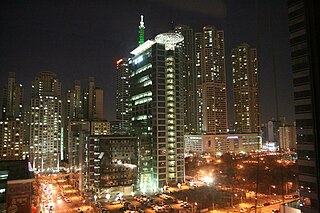
The Yangcheon District (Yangcheon-gu) is a gu,or district,of Seoul,South Korea,located on the southwest side of the Han River. At the centre of this district is the Mok-dong area,which is home to numerous shopping outlets,bars and restaurants,an ice rink,and large residential buildings inhabited by mostly upper-middle and upper-class families.
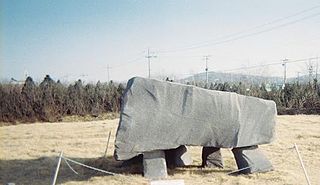
Ganghwa County (Korean: 강화군) is a county in the city of Incheon,South Korea. The county is composed of Ganghwa Island,and the minor islands around it.

The Meehambee Dolmen is a megalithic portal tomb dating from about 3500 BC located in County Roscommon,Ireland.

Anak County is a county in South Hwanghae province,North Korea.
Also known as the Yongin Wangsanli Dolmens, the Yongin Wangsanli Jiseongmyo are two single-chamber megalithic tombs from the Bronze Age located in Mohyeon-eup,Yongin-si,Gyeonggi-do,South Korea. Originally called Mohyeon Jiseongmyo, the name was changed to its current state under Gyeonggi-do Decree No. 2016–205 on November 8,2016. The dolmens were designated as Gyeonggi-do Monument No. 22 in 1974 for their historical value.
